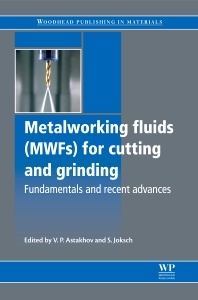Metalworking Fluids (MWFs) for Cutting and Grinding Fundamentals and Recent Advances Woodhead Publishing Series in Metals and Surface Engineering Series

The book opens with chapters considering the mechanism and action, selection and delivery of MWFs to the machining zone before moving onto discuss the many issues surrounding MWFs during machining such as selection of the proper MWF, environmental concerns, supply methods, circulation and monitoring. The final chapters discuss the maintenance, replacement and disposal of MWFs.
With its distinguished editors and international team of expert contributors, Metalworking fluids (MWFs) for cutting and grinding is an invaluable reference tool for engineers and organizations using metal cutting/machining in the manufacturing process as well as machine designers/manufacturers and machining fluid/chemical suppliers.
Contributor contact details
Chapter 1: Mechanisms of action of metalworking fluids in metal cutting
Abstract:
1.1 Introduction
1.2 Short history
1.3 Action of metalworking fluids (MWFs): general concept
1.4 Cooling action of metalworking fluids
1.5 Tribochemical action of metalworking fluids
1.6 Metalworking fluid penetration into contact zone
1.7 Multi-stage capillary representation of metalworking fluid lubrication action
Chapter 2: Selection and testing of metalworking fluids
Abstract:
2.1 Introduction
2.2 Types of metalworking fluids and significance in fluid selection
2.3 Fluid selection and testing for machining light metals
2.4 Fluid selection and testing for ferrous machining
2.5 Fluid selection and testing for superalloy machining
2.6 Other important fluid considerations
2.7 Conclusions
Chapter 3: Delivery of metalworking fluids in the machining zone
Abstract:
3.1 Introduction
3.2 Metalworking fluid (MWF) application methods
3.3 Application of metalworking fluids in deep-hole machining
3.4 Application of metalworking fluids in grinding
3.5 Application of cryogenic metalworking fluids (CMWFs)
3.6 Activation of metalworking fluids by external power influences
Chapter 4: Environmentally friendly near-dry machining of metals
Abstract:
4.1 Introduction: challenges of metalworking fluids (MWFs)
4.2 Near-dry machining (NDM) as a system: process and technology
4.3 Machining process stage
4.4 NDM setup and apparatus
4.5 Conclusions
Chapter 5: High-pressure supply of metalworking fluids
Abstract:
5.1 Basics: flow rate, pressure and pressure losses
5.2 Metalworking fluid (MWF) pressure versus the flow rate as related to functions of MWF
5.3 High-pressure metalworking fluids applications
5.4 Metalworking fluid pressure in the machining zone of a tool with an internal MWF supply
5.5 Conclusions
Chapter 6: Circulation systems for metalworking fluids
Abstract:
6.1 Introduction
6.2 Design of the metalworking fluid (MWF) circulation system
6.3 Metalworking fluid circulation system equipment
6.4 Future trends
Chapter 7: Monitoring metalworking fluids
Abstract:
7.1 Introduction
7.2 Basic safety standards and regulation
7.3 Non-water-based metalworking fluids (MWFs) (neat oil)
7.4 Water-based metalworking fluids
7.5 Online monitoring
7.6 Future trends
7.7 Sources of further information and advice
Chapter 8: Maintenance of metalworking fluids
Abstract:
8.1 Introduction
8.2 Mechanical/physical maintenance measures: an overview
8.3 Separation of solid contaminants
8.4 Separation of liquid contaminants
8.5 Chemical/physical measures
8.6 Replenishing metalworking fluids
8.7 Future trends
8.8 Conclusions
8.9 Sources of further information and advice
Chapter 9: Replacement of metalworking fluids
Abstract:
9.1 Introduction
9.2 Water-based metalworking fluids
9.3 Non-water-based metalworking fluids
9.4 Specific problems of changing from water-based to non-water-based fluids and vice versa
9.5 Future trends
Chapter 10: Disposal of metalworking fluids
Abstract:
10.1 Introduction: key issues
10.2 Technologies for oil-water emulsion separation
10.3 Chemical water treatment procedures
10.4 Physical water treatment processes: evaporation
10.5 Physical water treatment processes: membrane filtration
10.6 Waste fluid disposal
10.7 Future trends
10.8 Further reading
Index
Stefan Joksch is the Technical Director at Oemeta Chemische Werke GmbH.
- Chapters consider the mechanism and action, selection and delivery of MWFs to the machining zone
- Environmental concerns, supply methods, circulation and monitoring are also discussed
- Written by distinguished editors and international team of expert contributors
Date de parution : 01-2012
Ouvrage de 424 p.
15.5x23.2 cm


